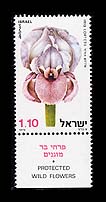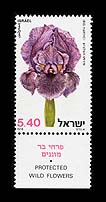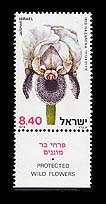|
|
There are 18 different species of wild Irises to be found in Israel which include some of the most beautiful and best-known flowers of our country. They are all "protected", which means that it is forbidden to pick them. Several of the species are extremely rare and found in very few areas.
The Irises form a large, varied group spread like a belt around the temperate northern hemisphere. The Iris is a perennial plant with a bulb, tuber or rootstock, characterized by its flower. Their perianth consists of six lobes - the outer three are bent downwards ("falls"), while the three inner ones stand erect ("flags"). Some species have large, variegated styles resembling the falls or the flags. This sometimes causes difficulties in understanding the structure of the flower. The Irises growing in Israel fall into several groups, of which one, the Oncocyclus, is unique.
The Oncocyclus
This group, comprising some fifty species, can be found in three main areas - Israel, Lebanon and Transcaucasus. They are perennials, have a rootstock and very beautiful blossoms different in shape from those of most other Irises. The flowers belonging to this group need specific climatic conditions - a warm summer, which they pass in hibernation; a not too rainy winter; medium temperatures. They are to be found, therefore, in a very limited region within which each species lives in a specific area suited to its needs. In Israel, eight or nine different kinds of the Iris Oncocyclus can be found, all of which are endemic, to be found nowhere else in the world. They are all characterized by their large, variegated, eye-capturing flowers. Each stem carries a single flower. They are scattered along a belt, or narrow strip which separates the Mediterranean -type areas from the desert.
The Purple Iris grows along the sandy belt of the Sharon Plain. In the north-western part of the Negev we find the Negev Iris, and eastwards, in the north-eastern part, the Yeruham Iris. The Gilboa Iris is to be found in north-eastern Samaria, Gilboa and West Golan, while the Nazareth Iris flourishes in Giv'at Ha-More and the mountains around Nazareth and Naphtali. Other kinds, such as the Lortet Iris and the Golan Iris are to be found in Nahal Hazor, the mountains of Naphtali and the Golan, respectively. The Oncocyclus, being a protected flower, unique to Israel, was chosen as the symbol of the Israel Society for the Protection of Nature.
The three stamps of this series illustrate three species belonging to this group of Irises. The Gilboa Iris - Iris Haynei -flourishes mainly on the Gilboa ridge and on the eastern slopes of the mountain. It was formerly believed to grow only on the Gilboa, but it is, in fact, spread over a wider area, extending southwards to East Samaria and northwards to the Golan. Though the colour of the blossoms is normally violet - in a wide variety of shades - some examples with yellow blossoms have been found. A plant may carry one or many flowers while the blossoming stem may grow as high as 18 inches, with its single flower attaining a diameter and height of four inches. It blooms from March to the beginning of April. The Gilboa Iris has been severely affected by uncontrolled picking and the wanton uprooting of its rhizomes (rootstocks), particularly by foreign gardeners interested in exporting them. Since the Law for the Protection of Wild Plants was passed (in 1964), most of these Irises have been preserved in the Gilboa Nature Reserve and hikers have, meanwhile, learned to respect them and to leave them undisturbed.
The Nazareth Iris - Iris Nazarena (Bismarckiana) - grows on Mt. Yona in the Nazareth hills, in the Giv'at Ha-More Nature Reserve and in some of the smaller Reserves in the Naphtali hill country. One can hardly find the right words with which to describe the colour of its flowers. The colour of the flags is light violet, while the falls are covered with large dots which sometimes merge to form a dark stain. The stems of the flower are shorter than those of the Gilboa Iris and their blossoms wider. They bloom from the end of February to the beginning of April. The Nazareth Iris was chosen as the emblem of the town of Upper Nazareth. The plant was christened "Bismarckiana" and "Nazarena" by different authors, unaware that they were dealing with the same plant. This confusion can be explained by the fact that they were working with dried specimens brought to Europe in the 19th century. Its scientific name is Bismarkiana, but it is better known by the name of Nazarena. The Golan Iris greatly resembles the Nazareth Iris in its blossoms, though it differs from it in some important details.
Lortet Iris - Iris Lortetii - grows in the Nahal Hazor Nature Reserve as well as in some other, smaller Reserves in the Naphtali hill country. This flower is generally considered to be the most beautiful of its group, with blossoms of the most delicate design.



